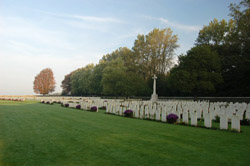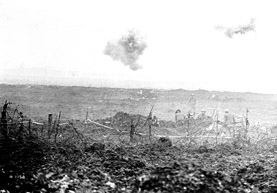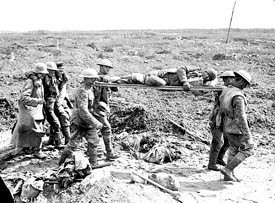

In memory of
Private
ALBERT J. (MOWAT) MOWATT
June 16, 1881 - April 9, 1917
Military Service:
Service Number: 703806Age: 28
Force: Army
Unit: Canadian Infantry (Central Ontario Regiment) Canadian Expeditionary ForceDivision: 102nd Battallion
Commemorated on Page 298 of the First World War Book of Remembrance.
Medium sized pop-up image
537 X 701, 96 dpi, 161 k
Military Attestation papers:
When a recruit signed up for the Canadian Expeditionary Force in WW I he filled in an attestation paper that indicated his willingness to serve in the military and provided such information as date of birth, next of kin, height, weight, complexion, occupation, etc. As such these papers are of genealogical importance. The links below are to a scanned copy of the attestion papers of Albert Mowatt completed on 1 February 1916, in Thurlow, British Columbia, when he was inducted into the 102nd Battalion (Comox-Atlin) of the Canadian Expeditionary Force.
Medium sized pop up image
of military attestation paper (front)
700 X 1129, 72 dpi, 41 kFull sized pop up image
of military attestation paper (front)
1012 X 1632, 72 dpi, 74 kMedium sized pop up image
of military attestation paper (back)
700 X 1129, 72 dpi, 30 kFull sized pop up image
of military attestation paper (back)
1012 X 1632, 72 dpi, 55 kDate of Enlistment:
Feburary 1, 1916, Thurlow, British Columbia, CanadaAdditional Information:
Private Albert Mowatt born 16 Jun 1881, son of Andrew Mowatt and Isabella Watt, Harvey, NB. Died 9 Apr 1917, WWI, Battle of Vimy Ridge, northern France.
Cemetery:
Canadian Cemetery No. 2, Pas de Calais,FranceThere is a Maple Leaf on the cemetery gate although the burials here are not exclusively Canadian. As well as the many known Canadian and British soldiers buried here there are also many unknown burials. In fact, more than two-thirds of those buried in the cemetery are "Known Unto God", as the inscription on their headstones reads. Although the cemetery was started just after the Canadians took Vimy Ridge in April 1917, the majority of the graves were moved here from elsewhere, over a period of years after the Armistice. They were either moved from smaller burial grounds, isolated graves or else were bodies recovered from the battlefield as the years went by. This explains the high proportion of unknown burials.
Location:
The Canadian Cemetery No. 2 is about 2.5 kilometres north of the village of Neuville-St. Vaast. The village is about 6 kilometres north of Arras and 1 kilometre east of the main road from Arras to Bethune. The cemetery is on a spur road turning left from the road to Givenchy-en-Gohelle, about 1 kilometre south of the Canadian Memorial at Vimy.Grave Reference:
Sp. Mem.
Canadian Cemetery No 2, Pas de Calais, France
Medium sized pop-up image
850 X 564, 300 dpi, 153 kCemetery Plan
Medium sized pop-up image
500 X 797, 72 dpi, 23 kNewspaper obituary
Copied from newspaper item (1917):
Harvey Man Killed.
Mr and Mrs Andrew Mowatt, of Harvey Station (N.B.) received a message last week informing them that their eldest son, Albert, who was a soldier in one of the Canadian regiments now serving in France, had been killed in one of the recent battles there. The deceased soldier left his home here about fourteen years ago and went to British Columbia, where he engaged in lumbering but shortly after the outbreak of the war enlisted in one of the British Columbia units. He is the fifth Harvey boy who has made the supreme sacrifice.The Battle of Vimy Ridge (9 -12 Apr 1917)
Map of Vimy Ridge.
Medium sized pop-up image
575 X 784, 72 dpi, 102 kVimy, located in northern France, was one of the most heavily defended points on the entire Western Front and was thought to be an impregnable fortress. The ridge was a key asset for most of World War I. Stretching from the town of Vimy to Givenchy-en-Gohelle, it was a crucial feature that allowed the Germans to control much of the surrounding territory. For the Allies, it was the only major barrier keeping them from the wide open Lens-Douai plain.
The German army fortified it with tunnels, three rows of trenches behind barbed wire, massive amounts of artillery, and numerous machine gun nests. The French and British had suffered thousands of casualties in previous attempts to take it; the French alone lost 150,000 men in 1915.
The Allied commanders decided to launch another assault in 1917. The duty was given to the still relatively fresh, but previously successful, Canadians. For the first time, all four divisions of the Canadian Corps were brought together. They were joined by the British 5th Infantry Division.
The Canadian Corps' commanders were determined to learn from the mistakes of the French and British and spent months planning their attack. They built a replica of the ridge behind their lines, and trained using platoon-level tactics, including issuing detailed maps to ordinary soldiers rather than officers or NCOs alone. Each platoon was given a specific task, rather than vague instructions from an absent general. They also employed older techniques such as the detonation of large mines under the German trenches.
On April 2, 1917, the Canadian Corps initiated the largest artillery barrage in history up to that point. They shelled the German trenches for a week, using over one million shells. The German artillery pieces were hidden behind the ridge, but by observing the sound and light from their firing, the Canadians were able to locate and destroy about 86% of the German guns. The Canadians also made many night trench raids during this week, although General Arthur Currie thought this was a stupid risk and a waste of men. The German troops called this period the "Week of Suffering". The attack was so loud, it could be heard in London.
Advanced reserves digging themselves in under shell fire during the Battle of Vimy Ridge.
Medium sized pop-up image
640 X 446, 72 dpi, 89 kAt dawn on Easter Monday, April 9, the 30,000-man Canadian Corps attacked, behind a creeping barrage. This tactic had been used earlier by the British at the Battle of the Somme, but there it had outpaced the soldiers. The Canadians perfected the technique. The troops walked across no man's land, just behind a continuous line of shells (an improvement over previous battles, in which both sides had often shelled their own troops). Several new and untested methods of counter-battery fire were also used successfully at the start of the battle. This disabled a large portion of the German artillery and protected the advancing infantry. The Canadians also used a new technique they called "Indirect Fire", which utilized machine guns to pin German troops down in their trenches and provide cover for their own troops.
After less than two hours, three of the four Canadian divisions had taken their objectives; the fourth division, however, was held up by machine gun nests on the highest point of the ridge, known as Hill 145. The 87th Battalion suffered 50% casualties. The 85th Nova Scotia Highlanders, who had been intended to function in a supply and construction role, were sent in as reinforcements and the hill was captured by the end of the day.
Stretcher bearers and German prisoners bringing in wounded at Vimy Ridge, during the Battle of Vimy Ridge.
Medium sized pop-up image
640 X 473, 72 dpi, 158 kIt is said that upon learning of the victory, a French soldier exclaimed, "C'est impossible!" ("It's impossible!"), and upon learning it was the Canadians who had done it, changed his answer to "Ah! les Canadiens! C'est possible!" ("Ah! The Canadians! It is possible!").
By April 12, the Canadians controlled the entire ridge, at a cost of 3,598 men killed and 7,104 wounded. The German Sixth Army, under General Ludwig von Falkenhausen, suffered approximately 20,000 casualties. The Canadians also took 4,000 Germans as prisoners of war. The loss of the ridge forced the Germans to retreat to the lower plains that were far more difficult to defend. The attack and objective had only limited grand-strategic significance, and as the simultaneous British and Australian attack to the south was unsuccessful, very little was actually achieved after the Canadian victory.
However, in a war in which, battle after battle, thousands died for gains measured in yards, the breakthrough had tremendous tactical significance. It relieved the city of Arras from the immediate threat of attack and proved that the front lines could be moved forward once again, after years of bloody stalemate. Vimy Ridge was the first Allied victory in almost a year and a half and it was especially demoralizing for the Germans who had viewed the ridge as one of their most impregnable strongpoints.
Source:
Wikipedia, Veterans Affairs Canada





